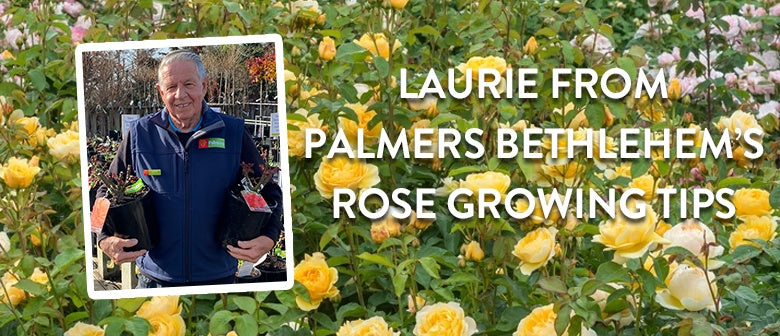Ask a Palmers Expert: Laurie’s rose growing tips
What are the secrets to growing the most beautiful roses? Life long rosarian, Laurie from Palmers Bethlehem says it’s all about getting the basics right – sun, soil, water and feeding. And getting to know your local rose society experts.
What is it about roses you love?
The incredible diversity in colour and wide range of growth habits, lending them to a wide range of uses in landscaping a garden. With the majority being repeat flowering, the long flowering season we have to enjoy them. Roses flower longer than just about any other shrub.
How many roses do you have in your garden?
Having downsized somewhat my current garden only has about 50. My previous garden had 250 plus. But there is always room for a rose! They even grow in pots.
What are your essentials for rose success?
Food, light and water. Roses need at least half a day full sun, but more is good. Reasonable spacing and not crowded with other kinds of plants. Feeding with quality fertiliser several times a season. Roses are hungry plants which we cut back each year and expect them to grow back to full size and provide us with an abundance of blooms. Apply fertiliser away from the crowns at the end of winter. As the season gets warmer and drier, keep plenty of water on the garden. I have found that spraying applications of seaweed products is very beneficial for foliage health as well.
What advice would you give someone who is a rose newbie?
Don’t rush it! Start with up to a half dozen for your first season. Ask questions of experienced growers – especially about which varieties are healthy and perform best without too much molly coddling. They do exist! Join your local rose society and question their experienced members. The New Zealand Rose Society publish their own newsletters cultural notes and annual publications reviewing rose cultivar performance.
What do you feed your roses?
A basic regime is to commence feeding at the end of winter. I do a smaller supplemental feeding around Christmas time and again in late summer to encourage a good autumn flush. I sometimes do other supplemental feeding with seaweed solutions or seaweed and fish. I get good results with Tui Rose Food and Tui Enrich Rose, Camellia, Azalea and Gardenia Food. I am a big fan of controlled release fertiliser and Yates Thrive Rose Food is also very good. I always start the season with an inclusion of sheep pellets. Roses seem to enjoy them. A good layer of compost helps with moisture retention while breaking down to valuable soil humus. Every second winter I also like to add a dressing of dolomite lime to supply calcium and magnesium. And don’t forget your local rose society for advice in regard to rose fertilising on your area’s soil types.
What is your advice for pruning roses and what advice would you give someone who is a bit nervous about pruning?
Use good tools; a sharp pair of good quality secateurs, a medium sized pair of loppers and a sharp, narrow bladed pruning saw. One of the folding varieties is usually adequate. Don’t prune too soon if you are in the warmer areas of the country as they will immediately start to put out new growth which may be damaged when it does become truly wintery. July to early August is best in this case. For the genuinely cold areas June is good. If there is white rose scale on the canes apply a spray of lime sulphur. This will kill the scale and defoliate the canes. Do this in late May to mid June before the canes are pruned. Don’t apply any other sprays in the next 3 weeks and then use a copper and oil preparation on the bushes. After pruning finish with a final oil spray. If you are a bit hesitant about it, find out where demonstrations are being done and go along. Most rose societies will be doing demonstrations in public gardens or at local garden centres and many garden centres do their own. Check with them. They are a valuable resource and cover more than we can here.
How do you get roses in pots off to a good start?
Begin with a decent sized container, measuring at least 40cm across the top. Give the rose a good prune to tidy and balance it. Use a good quality potting mix. The cheaper you go the less the potting mix has in it. The best ones hold moisture better as well as having more food. Replenish the slow release fertiliser a couple of times during the season or supplement with a good liquid food. At least every second season, prune the rose, remove it from its
pots and root prune before retuning to fresh potting mix. And don’t forget regular watering!
What are your new season’s rose top picks?

Pink Ribbon – Exclusive to Matthews Roses $2 from the sale of each rose will be donated to Breast Cancer Foundation NZ
Of the new releases I am interested in Rob Somerfield’s ‘Tropical Essence’, a highly perfumed compact climber. And from Matthews Roses, ‘Pink Ribbon’ looks promising – and it supports the Breast cancer foundation. Also from Kordes, the bright red compact ‘Rebel Spirit’ looks good for landscaping. Of recent releases I like ‘Looking Good’ and ‘My Mum’. Both are excellent garden performers.
What plants make good rose companions?
Well, the books tell us multitudes but I always liked hybrid Clematis intermingled with climbers. Around bushes you could use small growing lavender cultivars, marigolds, catmint to name a few. Garlic is a great companion for roses and can be harvested for food later. The main thing to remember is don’t over-plant and crowd your roses. They don’t enjoy that.

